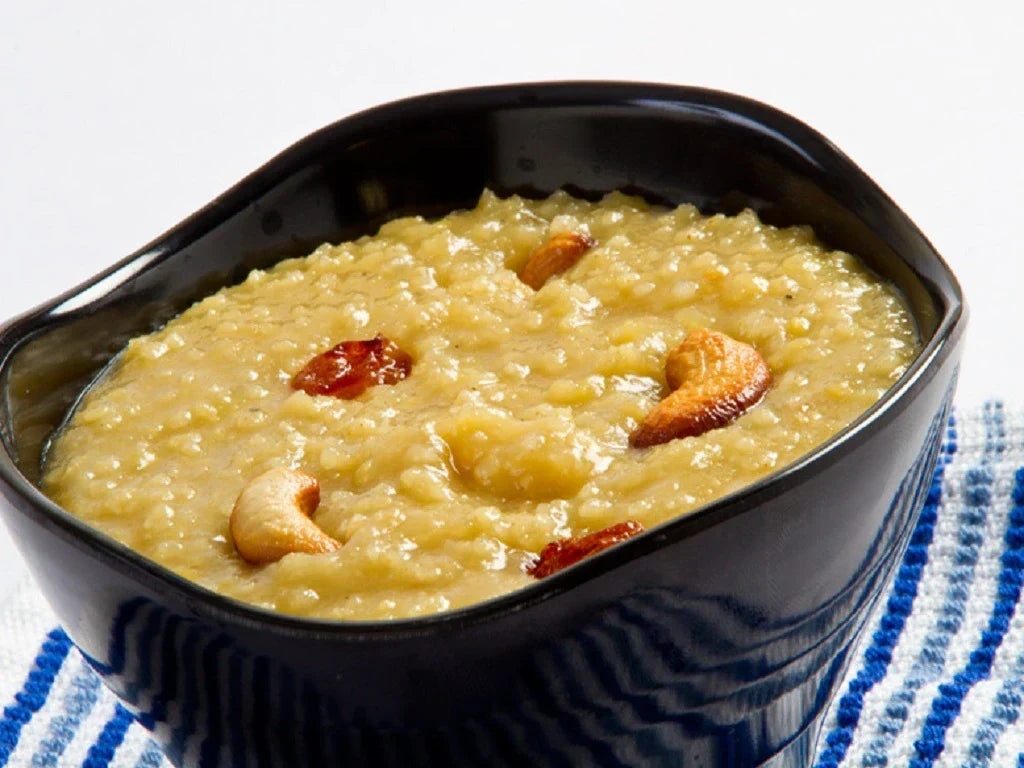
Sweet Pongal Recipe: How to Make Perfect Sakkarai Pongal at Home!
Share
Sweet pongal or commonly known as sakakrai pongal in Tamilnadu is a South Indian delicacy enjoyed mostly during festivities. This is traditionally made using the rice harvested before the Pongal festival. Pongal, which marks the beginning of the Tamil month Thai, is a festival dedicated to thanking nature, especially the Sun God, for a bountiful harvest.It is cherished as a symbol of prosperity and joy at the end of a long agricultural cycle that ends with harvest. Sweet pongal is also a regular ‘prasadam’ served in the South Indian temples.
While sweet pongal is traditionally made with rice, you can also add a little nutritious twist by replacing the rice with millets like thinai or foxtail millet for a variation to your regular sweet pongal. Read on as we bring to you the special recipe from Millet Maagic’s very own kitchen.
Sweet pongal vs Savoury Pongal
Pongal in general is a dish made out of rice and dal (usually moong dal). This can be done in two variations each in a different context. Sakkarai Pongal is sweet and rich and is usually associated with festivities, kara pongal or the savoury version of the pongal is a breakfast staple with additions like cumin, pepper, ginger, and curry leaves. It is a comfort meal unlike the sweet pongal which is a rich offering to the Gods.
Ingredients for Sakkarai Pongal using millets
- Thinai (Foxtail Millet) – 300 g
- Moong dal – 75 g
- Jaggery syrup – 300 g
- Elaichi (Cardamom) powder – 2.5 g
- Ghee – 30 g
- Cashew nuts – 5 g
- Raisins – 5 g
- Water – 300 g
How to Make Sakkarai Pongal
Step-by-Step Instructions
-
Roasting Ingredients:
Start by dry roasting Thinai (foxtail millet) and moong dal in a pan for 3–5 minutes, stirring continuously, until both ingredients are aromatic. -
Cooking the Base:
In a pressure cooker, add 1 ½ litres of water to the roasted mixture of millet and moong dal. Cook the mixture on medium heat for 3–4 whistles. Then, reduce the flame and let it simmer for 5 more minutes, ensuring the millet and dal are cooked soft and mushy. -
Preparing Jaggery Syrup:
In a separate pan, dissolve 300 g jaggery in 75 ml water. Boil the mixture for 5–10 minutes until it becomes a syrup. Strain the syrup to remove any impurities, then set it aside for later use. -
Combining:
Add the prepared jaggery syrup to the cooked millet and dal mixture. Stir well to ensure the syrup blends evenly, adjusting the sweetness to your preference. Let the mixture simmer for 5 minutes until it reaches a thick and consistent texture. -
Flavouring:
Add 2.5 g elaichi powder (cardamom) and 30 g ghee to the mixture. Stir well to ensure that the flavours infuse. -
Roasting Cashews and Raisins:
In a small pan, heat a little ghee and roast the cashews and raisins until golden brown. Pour them over the prepared pongal as a garnish. -
Serving:
Serve the Thinai Sakkarai Pongal warm. Optionally, garnish with extra dry fruits like almonds or pistachios for added texture and flavour.
Tips for Perfect Sweet Pongal
Achieving the perfect Sakkarai Pongal requires attention to texture, sweetness, and flavour balance. Here are some tips to perfect the dish:
-
Achieving the Right Texture:
For a perfect Pongal, ensure the millet and dal are soft but not too mushy. If you prefer a firmer texture, reduce the water slightly or cook the mixture for less time. - For an authentic flavour, you can add edible camphor or nutmeg powder in very small quantities for a more traditional taste.
-
For an extra crunch, consider adding Millet Ribbon Murukku as a topping.,

To enhance sweetness, pair your dessert with Millet Choco Dip Cookies.
Variations of Sweet Pongal
Vegan Sweet Pongal
For a plant-based version of this dish, replace ghee with coconut oil or vegan butter. The natural sweetness of jaggery will still pair well with the coconut oil.
Low-Calorie Pongal
To make a low-calorie version, reduce the amount of ghee and replace jaggery with stevia or dates.
Other Millet Based variations
Apart from foxtail millet, you can also make sweet pongal using kodo millet, or barnyard millet or even proso millet.
FAQs
1. How to make sweet Pongal quickly?
The quickest way to make sweet Pongal is by using a pressure cooker. Cook the roasted millet and dal for 2-3 whistles, prepare the jaggery syrup in advance, and mix everything together for a faster cooking time.
2. What are the key ingredients of Sakkarai Pongal?
The essential ingredients of Sakkarai Pongal include rice (or millet), moong dal, jaggery, and ghee, which form the base of this sweet, comforting dish.
3. Can I make Sakkarai Pongal without ghee?
Yes, you can substitute ghee with coconut oil or vegan butter for a dairy-free or vegan version. The dish will still have a delicious flavour, though slightly different in texture.
4. How do I store Sweet Pongal?
Store leftover Sakkarai Pongal in an airtight container in the refrigerator for up to 2-3 days. Reheat by adding a little warm water or milk to restore its original consistency.
5. What is the difference between Sakkarai Pongal and Chakkara Pongali?
The difference lies mainly in the region. Sakkarai Pongal is commonly prepared in Tamil Nadu, whereas Chakkara Pongali is the Andhra and Telangana version. Both use similar ingredients, but regional variations in flavouring and preparation may exist.
Liked this recipe? Follow our other blogs for awesome and healthy millet recipes and benefits!
Check out our range of gluten free, healthy millet delights here.
